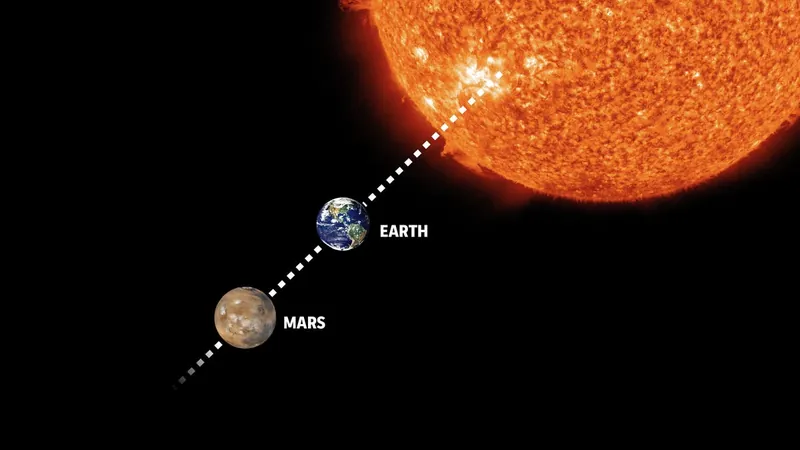
Experience the Spectacular: Mars Set to Dazzle in January!
2025-01-12
Author: Amelia
Experience the Spectacular: Mars Set to Dazzle in January!
This January, skywatchers are in for a spectacular treat as Mars will shine its brightest and appear larger than ever when it reaches its closest point to Earth in a phenomenon known as "opposition." Mark your calendars for January 12, when the Red Planet will be at its perigee, just days before its opposition with the sun on January 15.
So, what exactly does it mean for Mars to be “in opposition?” Essentially, this occurs when Mars is perfectly aligned with the Earth and the sun, making it fully illuminated by sunlight. Just like a full moon, this celestial setup offers incredible viewing conditions from our planet, allowing Mars to dominate the night sky throughout January.
This rare astronomical event takes place roughly every two years. This time, it coincides with Mars' retrograde motion, which started on December 7 and will continue until February 23. During this period, Mars will appear to move “backward” in its orbit as seen from Earth, an optical illusion that can confuse even the most seasoned stargazers. Mars undergoes retrograde about every 26 months and lasts for approximately two and a half months, making this event a must-see.
Viewing Mars: An Easy Guide
If you're anxious to catch a glimpse of Mars in all its glory, simply look to the eastern horizon at sunset on January 15. The Red Planet will rise with the sun and remain visible throughout the night, shining brightly near the constellation Gemini.
Fascinating Facts About Mars
Mars is not just a bright dot in our sky; it's the fourth planet from the sun and has captivated civilizations for centuries. Its vibrant red hue—caused by iron minerals oxidizing—has inspired names from ancient cultures. The Romans named it after their god of war, while the Egyptians referred to it as "Her Desher," meaning "the red one."
Mars has a unique orbital period, taking 687 Earth days (or nearly 1.8 years) to complete one revolution around the sun. Additionally, it boasts two small moons, Phobos and Deimos, which are intriguing subjects for further study.
Don't Miss Out!
With the alignment of Mars, the opportunity to observe this majestic planet in all its splendor is rare. Whether you're an accomplished astronomer or an amateur enthusiast, January 2024 promises a dazzling display you won't want to miss! Set your sights on the night sky and prepare for a cosmic experience that could reignite your fascination with the universe!



 Brasil (PT)
Brasil (PT)
 Canada (EN)
Canada (EN)
 Chile (ES)
Chile (ES)
 Česko (CS)
Česko (CS)
 대한민국 (KO)
대한민국 (KO)
 España (ES)
España (ES)
 France (FR)
France (FR)
 Hong Kong (EN)
Hong Kong (EN)
 Italia (IT)
Italia (IT)
 日本 (JA)
日本 (JA)
 Magyarország (HU)
Magyarország (HU)
 Norge (NO)
Norge (NO)
 Polska (PL)
Polska (PL)
 Schweiz (DE)
Schweiz (DE)
 Singapore (EN)
Singapore (EN)
 Sverige (SV)
Sverige (SV)
 Suomi (FI)
Suomi (FI)
 Türkiye (TR)
Türkiye (TR)
 الإمارات العربية المتحدة (AR)
الإمارات العربية المتحدة (AR)